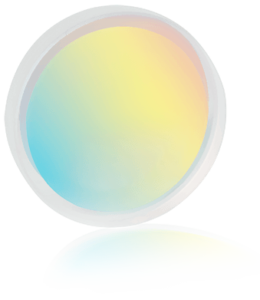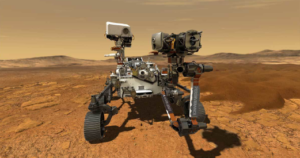 Has there ever been life on Mars? That is the question the Mars 2020 rover Perseverance seeks to answer, and a Wasatch Photonics grating is on board to help find the answer. When the Mars 2020 mission took off from Cape Canaveral, Florida on July 30th, 2020, it carried a scientific payload designed to build on the knowledge gained from the Mars Science Laboratory mission deployed in 2011, which found evidence that Mars could have supported microbial life at one time.
Has there ever been life on Mars? That is the question the Mars 2020 rover Perseverance seeks to answer, and a Wasatch Photonics grating is on board to help find the answer. When the Mars 2020 mission took off from Cape Canaveral, Florida on July 30th, 2020, it carried a scientific payload designed to build on the knowledge gained from the Mars Science Laboratory mission deployed in 2011, which found evidence that Mars could have supported microbial life at one time.
WATCH THE JULY 30 LAUNCH MISSION UPDATES
The Perseverance rover has several key mission goals: to better understand the geologic diversity of Mars, to assess habitability and look for bio-signatures indicating past life, to characterize the climate of Mars, and perform experiments designed to prepare for human exploration of the Red Planet in the 2030’s. It will also collect and cache promising samples for future analysis.
Perseverance carries seven instruments in total, one of which is SuperCam, an advanced remote optical sensing instrument to provide imaging, chemical composition analysis, and mineralogy. It builds on the ChemCam design already deployed on the Curiousity rover in 2011, adding Raman and time-resolved fluorescence spectroscopy designed with a Wasatch Photonics VPH grating as the dispersive element.
The Science of SuperCam
SuperCam is comprised of several instruments in itself, which together will help detect and analyze organic and mineral content on the Mars surface. Their optical paths have been co-aligned to provide rapid, complementary data to characterize the same pinpoint target: laser induced breakdown spectroscopy (LIBS), Raman and time-resolved fluorescence (TRF), visible and near-infrared spectroscopy, and high resolution color remote micro-imaging.
The Raman and TRF capabilities developed for SuperCam are new, and employ a transmission spectrometer with a VPH grating and gated detector. This allows the same spectrometer to be used for both techniques. In Raman, the detector gating reduces interfering fluorescence and ambient sunlight. In fluorescence, an adjustable delay between the laser pulse and spectral detection allows studies of time-resolved fluorescence. A 532 nm doubled YAG laser will be used for excitation, allowing detection of many Raman-active minerals at a working distance of up to 12 m. For targets within 7 m of the rover, shock waves generated by the laser serve to blast away dust, yielding a cleaner surface for analysis.
 Wasatch Photonics is delighted to provide the VPH grating used as the dispersive element in the SuperCam Raman spectrometer. Transmission spectrometers facilitate simple, compact designs, making them well suited to applications where low size, weight, and power (SWaP) are extremely important. Learn more about the many advantages of VPH gratings
Wasatch Photonics is delighted to provide the VPH grating used as the dispersive element in the SuperCam Raman spectrometer. Transmission spectrometers facilitate simple, compact designs, making them well suited to applications where low size, weight, and power (SWaP) are extremely important. Learn more about the many advantages of VPH gratings
Surviving a Hostile Environment

The environment seen by any instrument deployed to deep space or even low-earth orbit is very demanding, with temperatures and radiation exposure well outside typical use. It is thus necessary to understand the behavior of each component through rigorous testing to ensure no change in performance. Depending on the expected conditions for the mission and lifetime required, this may include (but is not limited to) mission-specific tests for thermal cycling, mechanical shock and vibration, and space radiation testing to assess the potential for solarization of glass due to gamma radiation, proton radiation, and/or lower energy UV radiation.
The choice of glass used in each optical component is therefore critical. At Wasatch Photonics, we often work to accommodate specific glass types requested by research and OEM customers, adapting the grating design accordingly for maximum efficiency at the desired dispersion, center wavelength, and bandwidth conditions. The flexibility in design resulting from our process of imaging the grating holographically in dichromated gelatin allows us to meet particularly challenging combinations of optical parameters such as broad bandwidth, low polarization dependency, and high efficiency.
“We are proud to contribute to the advanced technology that is facilitating the search for signs of past life on Mars,” says senior optical engineer Elroy Pearson. “So many photonics companies have contributed components and technology to this project, in addition to the tremendous efforts of NASA scientists and collaborators over many years. It’s a testament to what we can accomplish together when we each play our part,” says CEO David Creasey.
Stay updated on the latest Mission to Mars on the NASA website, and find ways to join the excitement! We can’t wait to see you there.
Published July 27th, 2020 | Updated September 16th, 2020
References
“Mars 2020 Perseverance Rover.” NASA, NASA, 2020, mars.nasa.gov/mars2020/.
Wiens, Roger C., et al. “The SuperCam remote sensing instrument suite for Mars 2020.” 47th Lunar and Planetary Science Conference, 2016, pp.1322.
Maurice, Sylvestre, et al. “The SuperCam instrument for the Mars2020 rover.” (2015), European Planetary Science Congress, Vol. 10, EPSC2015-185.


